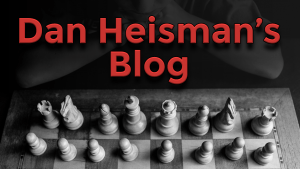Q&A with Coach Heisman May 10, 2013
A viewer asked if, in the Ruy Lopez, White should play 5.d3 or 5.O-O after 1.e4 e5 2.Nf3 Nc6 3.Bb5 a6 4.Ba4 Nf6:
I responded that while 5.d3 is currently fashionable among some higher level players, that does not make it better. Top GMs are only human and want a little variety in their lives. Trying something different is interesting and, as computers will often show us, not necessarily bad. Less book to know in that line (good!). But that fashion doesn't mean that if you are studying this opening and wish to consider 5.d3, that it's no longer useful to learn the standard-bearer 5.0-0 or that those who play it should abandon it. It's very much a matter of "style". See my link near the end of this article if you are interested in the (old) tabiya for the standard moves in the Closed Ruy Lopez.
Someone saw the CCRL Computer Ratings and asked "Those ratings are way over 3000 and the top players in the world are only about 2700 - how can that be?" Of course, the days of top GMs playing big money matches vs top computers is over. The top computers inevitably began to win, so playing them at their top level has become more and more like racing against a car. So some humans can go in denial, but yes, the top computers are much better than the top players now and pulling away. Their 3000+ ratings are derived from the computers playing each other but, when they do play humans, it's quite apparent they are now dominant. I quoted GM Nigel Short from New in Chess as saying a couple years ago that he plays speed games against his computer "looking for a draw that never comes." Apparently another event just ended with current #1 Houdini winning - info via https://www.facebook.com/tcec.chess.
In a similar vein, a viewer asked the interesting question of what an entity's rating would be if it played perfect chess. There may be some way of estimating this but I did not know one off the top of my head. My guess was in the 3600-3700 range, assuming no inflation from the current status quo. I used to think this answer was much lower but proceedings over the past 20 years has forced me to raise my estimate.
Some of the questions on today's show were of the "What's the best way to learn X?" variety and I often responded with one of my standard answers, which was to play mostly somewhat stronger players in long time control games (and play slowly!), and review the game with them afterwards. Even better if you can get a strong player (assuming your opponent is not that person) to review the game with you.
Another questioner asked me how I begin analyzing a position. I responded by saying the answer depended on whether I was in the middle of a game or was presented a position "cold". In the middle of a game I already know what is going on at the time the opponent makes a move. Moreover, it is unlikely that a strong player has "left over" a missed tactic from the previous move, so I can concentrate on all the ways the opponent's move has affected the position (including key issues left from previous moves). I commented on this interesting subject in my Chess.com blog The Ways a Move Affects the Board (interesting comments by Chess.com readers as well). When there is a position presented to me "cold", then I have a assess the position, including a static (and likely dynamic) evaluation of who stands better, how much, and why? If it is a "play and win" puzzle, of course, then no matter the current situation, I have to start analyzing how I can reach a situation - by force -where the side required to win is winning. This "problem" analysis all begins with counting the material, of course. Nothing worse than doing a tactics problem where you finally figure out a way to win a knight, think that's the answer, and then discover you were down a rook at the beginning, leaving you still behind the exchange.
The issue of definitions came up. There is no official dictionary of chess. For example, IM Silman (and others) have defined a backward pawn as having to be on a semi-open file. Nothing wrong with that - it's reasonable but my definition includes the idea that a backward pawn does not have to be on a semi-open file. So long as you define your terms reasonably and use them consistently, that's OK with me. For more on backward pawns, see the 4th edition of my first book, Elements of Positional Evaluation.
Another viewer seemed to think the difference between visualization and calculation was small and wished a clarification. By my definitions the difference is clear: visualization is the capability to imagine where the pieces would be during analysis of possible sequences. For example, if you look at the beginning chess position and think "If I go 1.a4,he may respond 1...e5" and see this position's "picture" in your mind, that's visualization. But calculation (again just my definition), is analyzing forcing sequences to see where they lead - i.e., creating a tree of forcing moves and conclusions. This is something you would do in analytical positions or any "play and win" or "play and mate" or "play and draw" problem. Calculation, like any analysis, requires visualization, but it also involves many other analytical skills such as deductive logic and pattern recognition. For example, you might calculate in a position, "If I play Bg5 and attack his queen, he has only three moves that might save it..."
One or two questions brought up the subject of time management, which led me to quote one of my favorite pieces of advice: "Never start a game without the intention of using almost all your time."
I think the easiest question was when a clever viewer asked me my shoe size. It's 11 if the shoe manufacturer tends to make smaller shoes and 10.5 if they run large. Astutely, I think the person asking this question is a "shoe-in" to gain several hundred rating points. Anyone who says otherwise is a heel and we shall, inevitably, go toe-to-toe (etc...).
Other references from the show today included:
- Pawn Structure Chess - Soltis (book)
- Everyone's Second Chess Book - Heisman
- The World's Most Instructive Amateur Game Book - Heisman
- Pawn Power in Chess - Kmoch (book)
- The Theory of Chess Improvement
- The Improvement Feedback Loop
- Misquoted or Misinterpreted
- Annotated Game Collections vs. Instructive Anthologies
- A Different Approach to Studying Tactics
- The Closed Ruy Lopez
- Team 45 45 League






